2012年06月28日
City Center Renewal
As some of you may have noticed, I am quite curious about the redevelopment of Takamatsu's central shotengai (shopping street), the 'longest covered arcade' in Japan. (See http://cathy.ashita-sanuki.jp/d2010-12.html and http://cathy.ashita-sanuki.jp/d2011-12.html ) This major project was launched over 20 years ago in 1988 when the shop owners banded together to save the commercial and social heart of the city from the steady encroachment of major shopping malls and chain stores. Last month marked the much-anticipated opening of the last, and biggest, section of the Marugamemachi shopping district redevelopment project.

Of course, I went down to take a look and to ask people how it's going. I found that this particular section has a very different feel from the redeveloped north end. Although covered, it almost doesn't seem like it.
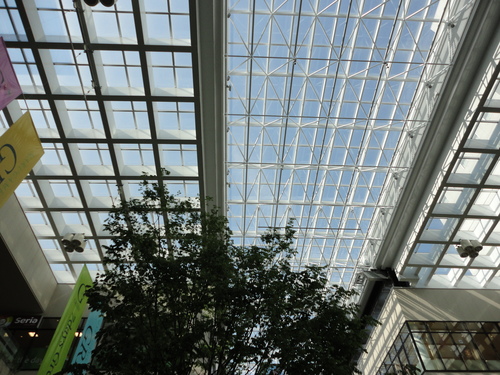
The roof is several stories up and transparent, and covers a large plaza complete with trees.
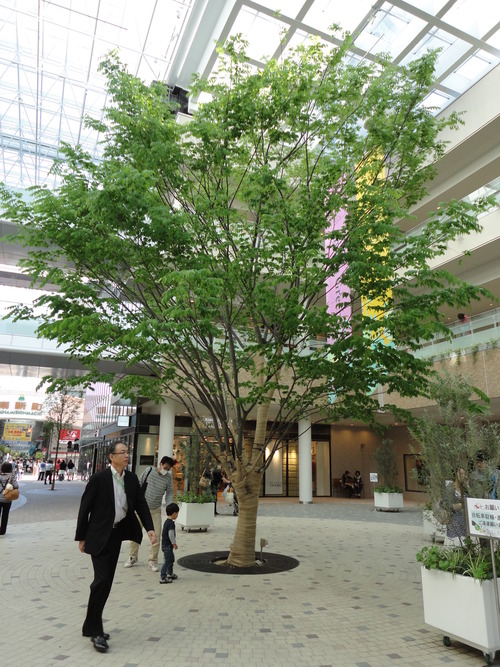
Whereas the north end still retains the feel of individual, and even family run shops, this area leans more towards trendy shops imported from large urban centers in Japan and elsewhere.
Like Floresta Doughnuts

Jupiter Import Foods

Tower Records

and John Masters Organics
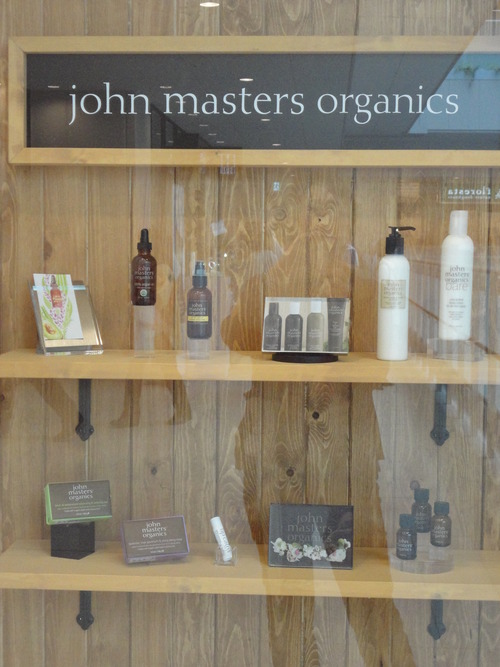
Some local shops have actually moved in from other parts of Takamatsu, like one of the city's famed bakeshops, Lowe.
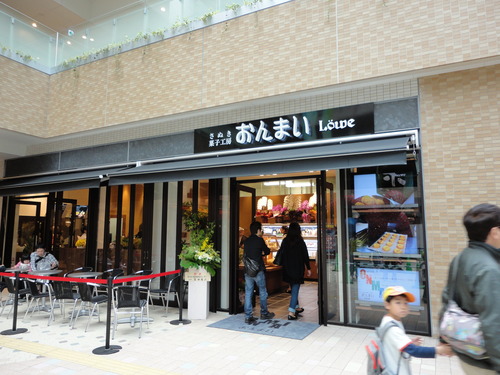
The redevelopment concept for this section was inspired by a shop owner's trip to Shanghai, where he experienced an urban shopping street with shoppers relaxing at outdoor cafes. Mori Urban Planning Corporation (think, Roppongi Hills, Omotesando Hills, Shanghai World Financial Center) was brought in to make this vision a reality. The idea is to have a steady flow of customers passing from one end of the arcade to the other and enjoying the differences in style and atmosphere.
Not sure what Spiderman had to do with all this

but he was there at the opening.

One sign that suggests the concept is succeeding, at least for now, is that there are far more people in the arcade these days than I ever remember seeing.
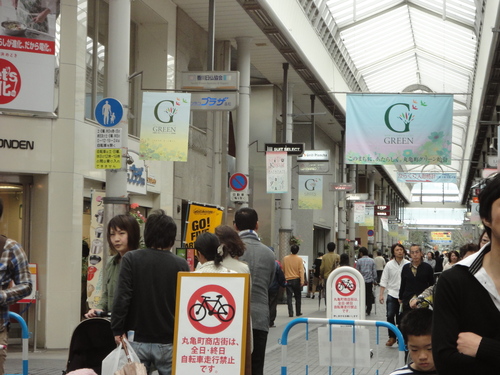
Furthermore, the crowds include lots of young people and families with young children.


Malls on the outskirts of town usually draw young families because they have large parking lots. I'm hoping that these families are learning to ride public transit but am guessing the arcade's new parking lot has something to do with this. I do, however, really like the new rule banning bikes from the arcade and the new bicycle parking lot that supports it just outside the arcade entrance.
Here's the bike parking entrance so you'll know what to look for.


The arcade is actually really nice to stroll through, which as far as I'm concerned a mall is not.

Of course, I went down to take a look and to ask people how it's going. I found that this particular section has a very different feel from the redeveloped north end. Although covered, it almost doesn't seem like it.
The roof is several stories up and transparent, and covers a large plaza complete with trees.
Whereas the north end still retains the feel of individual, and even family run shops, this area leans more towards trendy shops imported from large urban centers in Japan and elsewhere.
Like Floresta Doughnuts
Jupiter Import Foods
Tower Records
and John Masters Organics
Some local shops have actually moved in from other parts of Takamatsu, like one of the city's famed bakeshops, Lowe.
The redevelopment concept for this section was inspired by a shop owner's trip to Shanghai, where he experienced an urban shopping street with shoppers relaxing at outdoor cafes. Mori Urban Planning Corporation (think, Roppongi Hills, Omotesando Hills, Shanghai World Financial Center) was brought in to make this vision a reality. The idea is to have a steady flow of customers passing from one end of the arcade to the other and enjoying the differences in style and atmosphere.
Not sure what Spiderman had to do with all this
but he was there at the opening.
One sign that suggests the concept is succeeding, at least for now, is that there are far more people in the arcade these days than I ever remember seeing.
Furthermore, the crowds include lots of young people and families with young children.
Malls on the outskirts of town usually draw young families because they have large parking lots. I'm hoping that these families are learning to ride public transit but am guessing the arcade's new parking lot has something to do with this. I do, however, really like the new rule banning bikes from the arcade and the new bicycle parking lot that supports it just outside the arcade entrance.
Here's the bike parking entrance so you'll know what to look for.
The arcade is actually really nice to stroll through, which as far as I'm concerned a mall is not.
Posted by cathy at
04:21
│Comments(1)
2012年06月28日
Castle Manor
Takamatsu was ruled by the Matsudaira clan during the Edo period (1603-1868). During the Meiji Restoration, however, rule by daimyo (territorial lords) in Japan was abolished along with the samurai class. Takamatsu castle was decommissioned and the castle keep was dismantled. Although the Matsudaira family no longer ruled, they still owned a fair bit of land, and the family head built himself a stately manor within the former castle grounds as his second house. It took three years and was completed in 1917.

View of Hiunkaku from a castle turret
The manor is actually built in the same style as the residences many daimyo lived in during the Edo period. It is comprised of a series of buildings all joined by covered passageways and opening onto courtyard gardens.
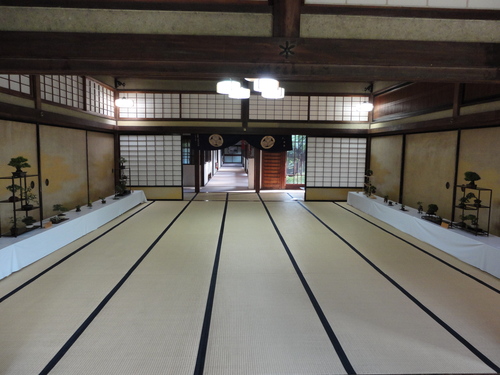
Looking down a passageway.
The large entrance way was originally designed to fit the lord's palanquin, for door-to-door chauffeur service. A rickshaw would fit in here fine, too.


Each room is named after the view it offers, such as “pine-tree room”, “cycadophyte room”, and “wave room” (on the second floor looking out to sea).
The “cycadophyte room” is huge, with very few pillars to obstruct the view.

And of course the view is cycadophytes.
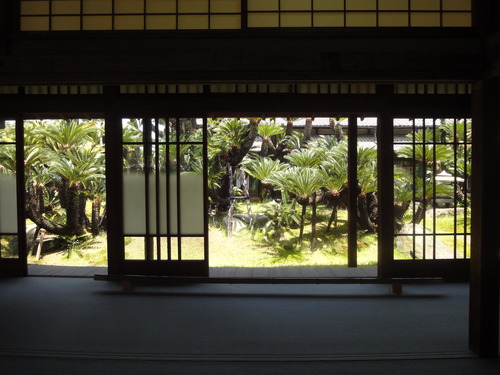
In typical understated Japanese fashion, the workmanship is exquisite, combining traditional Japanese woodwork, stonework and gardening with such Western touches as German glass for the window-panes (now almost 85 years old).
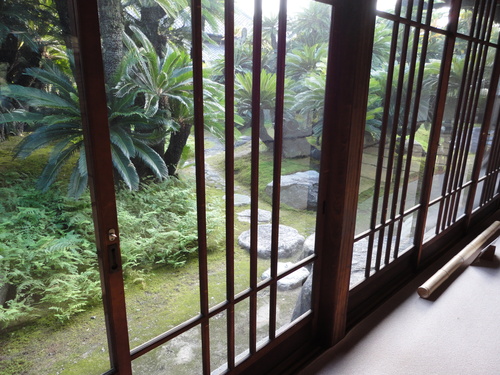
Although it has been designated as an important cultural property, it's still very much in use for exhibitions, weddings, concerts, tea ceremony, and public viewing.
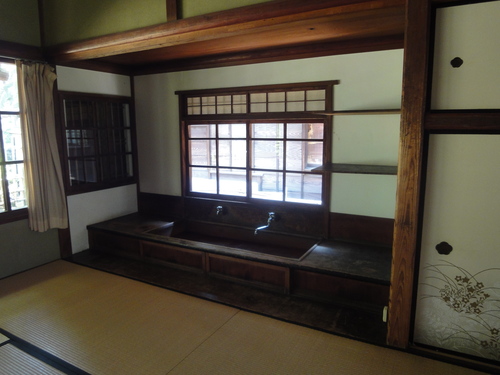
Sink area for preparing tea ceremony
It was also used as the set of “Haru no Yuki”, a movie based on Yukio Mishima's novel, Spring Snow. They accidentally broke one of the glass panes in the window during filming. Hard to replace 85-year-old German glass I expect. The room on the second floor is where the Showa emperor stayed.

I'll finish off with some other interesting touches that it's sometimes hard for a non-Japanese eye to catch.
The stepping stones (tobi-ishi) in the garden are huge making me feel like Gulliver in the land of the giants.


The stone water basin below (chozu bachi) for washing hands and mouth before the tea ceremony is also enormous and it comes with a long-handled dipper. It makes you wonder what kind of guests they were expecting.
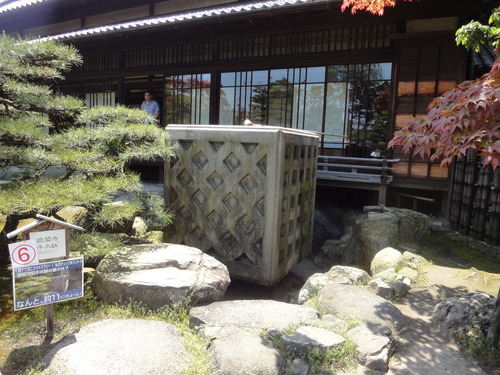
And what are all the coins doing on this rock? Take a look at the little pine sapling growing out of the crack. The coins are a tribute to that feisty seedling for sprouting in such an inhospitable place. Japanese people often pay tribute and respect to the spirit they sense in nature and this tree has become like a mini-shrine.
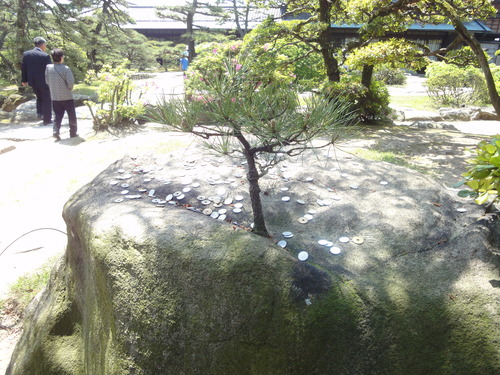
Having once aspired to be a carpenter, I can't help but admire this door made of a single sheet of superbly grained wood. And these doors are designed not to stick either. (The bottom runner extends the entire length of the door so that there's no uneven shrinkage.)

It may be hard to see in the photo below, but the residents did not want the gardeners traipsing through their house to tend the plants in the inner courtyards. So they built passageways under the corridors for the gardeners to get through.

Hiunkaku is located in Tamamo Park just across from Takamatsu JR station.
Admission: 200 yen for adults. No extra admission for Hiunkaku. Free Jan. 1-3, May 5.
Park hours: 5:30 AM to 19:00 in summer; 7:00 AM to 17:00 PM in winter. Closed Dec. 29-31.
View of Hiunkaku from a castle turret
The manor is actually built in the same style as the residences many daimyo lived in during the Edo period. It is comprised of a series of buildings all joined by covered passageways and opening onto courtyard gardens.
Looking down a passageway.
The large entrance way was originally designed to fit the lord's palanquin, for door-to-door chauffeur service. A rickshaw would fit in here fine, too.
Each room is named after the view it offers, such as “pine-tree room”, “cycadophyte room”, and “wave room” (on the second floor looking out to sea).
The “cycadophyte room” is huge, with very few pillars to obstruct the view.
And of course the view is cycadophytes.
In typical understated Japanese fashion, the workmanship is exquisite, combining traditional Japanese woodwork, stonework and gardening with such Western touches as German glass for the window-panes (now almost 85 years old).
Although it has been designated as an important cultural property, it's still very much in use for exhibitions, weddings, concerts, tea ceremony, and public viewing.
Sink area for preparing tea ceremony
It was also used as the set of “Haru no Yuki”, a movie based on Yukio Mishima's novel, Spring Snow. They accidentally broke one of the glass panes in the window during filming. Hard to replace 85-year-old German glass I expect. The room on the second floor is where the Showa emperor stayed.
I'll finish off with some other interesting touches that it's sometimes hard for a non-Japanese eye to catch.
The stepping stones (tobi-ishi) in the garden are huge making me feel like Gulliver in the land of the giants.
The stone water basin below (chozu bachi) for washing hands and mouth before the tea ceremony is also enormous and it comes with a long-handled dipper. It makes you wonder what kind of guests they were expecting.
And what are all the coins doing on this rock? Take a look at the little pine sapling growing out of the crack. The coins are a tribute to that feisty seedling for sprouting in such an inhospitable place. Japanese people often pay tribute and respect to the spirit they sense in nature and this tree has become like a mini-shrine.
Having once aspired to be a carpenter, I can't help but admire this door made of a single sheet of superbly grained wood. And these doors are designed not to stick either. (The bottom runner extends the entire length of the door so that there's no uneven shrinkage.)
It may be hard to see in the photo below, but the residents did not want the gardeners traipsing through their house to tend the plants in the inner courtyards. So they built passageways under the corridors for the gardeners to get through.
Hiunkaku is located in Tamamo Park just across from Takamatsu JR station.
Admission: 200 yen for adults. No extra admission for Hiunkaku. Free Jan. 1-3, May 5.
Park hours: 5:30 AM to 19:00 in summer; 7:00 AM to 17:00 PM in winter. Closed Dec. 29-31.
Posted by cathy at
02:39
│Comments(0)



